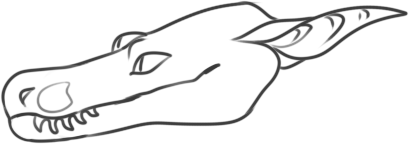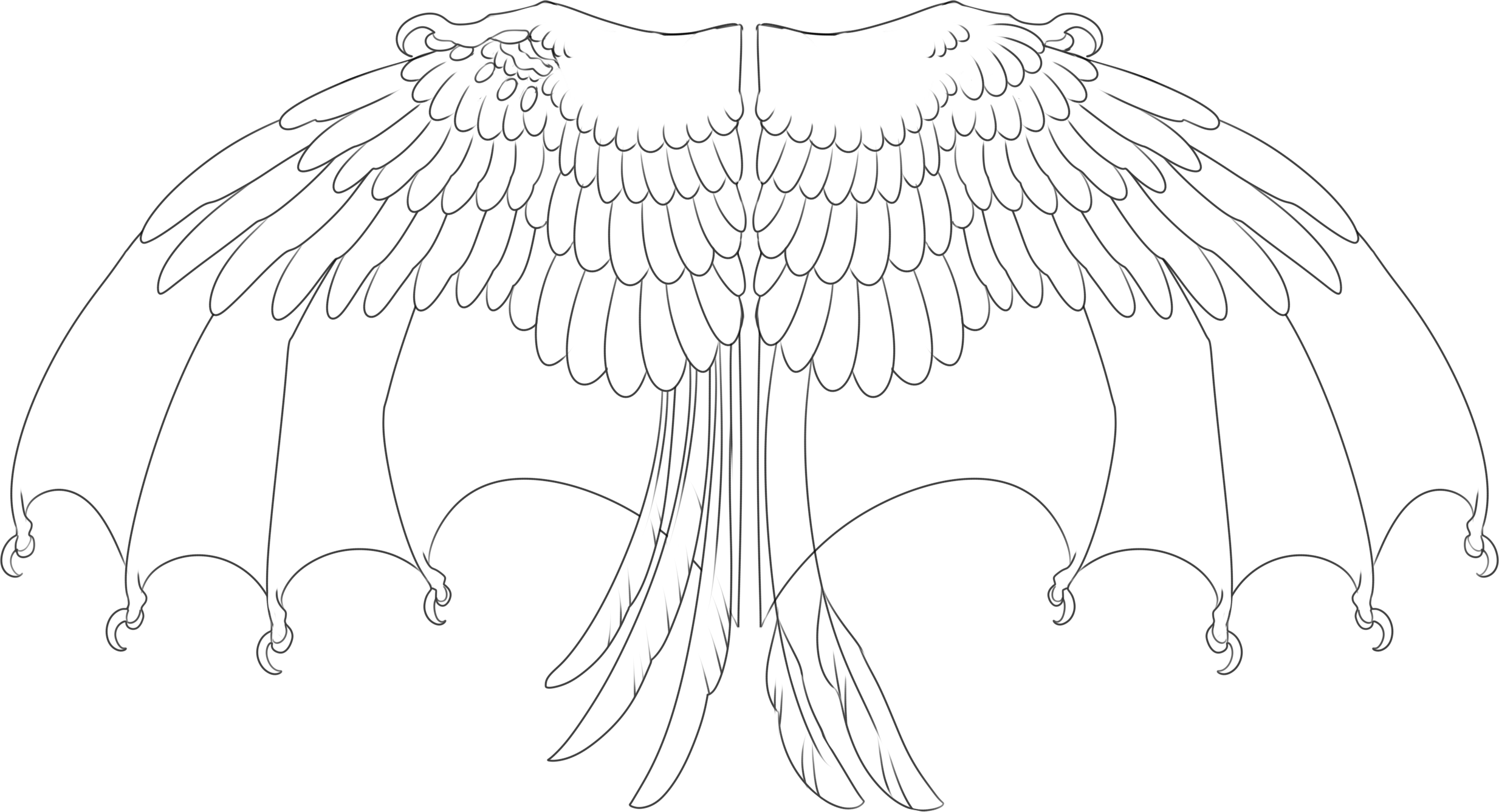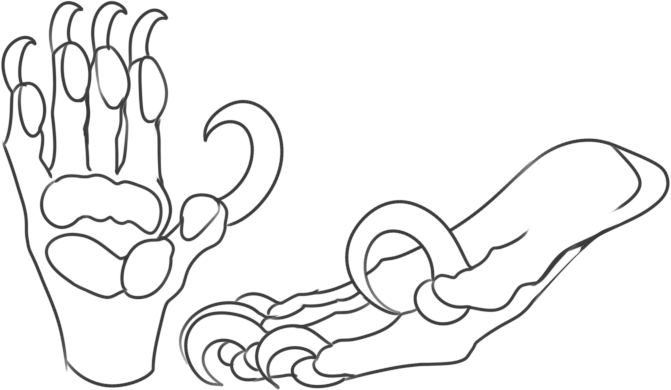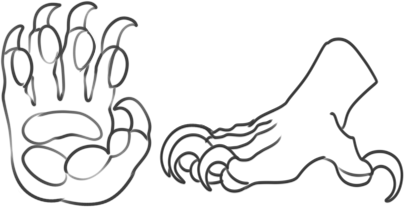nocmyr TRAITS
Return to Nocmyr Species Directory
The Sialla Nocmyr are a very diverse species.
Heads
Nocmyr have long, spinosaurid-like heads with three eyes.


Standard
- Average Nocmyr head, with a long snout

Brachycephaly
- Shorter snout, rounder features

Dolichocephaly
- Longer snout than average

rounded
- Rounded forehead and snout

Beak
- Beak-shaped snout; not a real beak

overbite
- Prominent overbite

gharial
- Longer, pointed snout, like that of a gharial

upturned
- Upturned snout

buzzsaw
- Second set of exposed teeth
Dermis
Nocmyr skin is covered in small scales. Nocmyr may also grow larger, armored scales anywhere on their body as well. Nocmyr may grow any amount of horns or spines on their bodies. Nocmyr will regularly shed their skin as they grow, but do not consume it. Colorful, reflective scales are considered attractive to Nocmyr.
Scales
granular
- Bumpy, raised scales of varying size and shape

keeled
- Scales with a central ridge, can be platelike or imbricate

cycloid
- Overlapping, round scales

Dermal growths
scutes
- Dermal growth similar to scales. Vary in size, from small bumps to prominent ridges.

osteoderms
- Bony deposits that form plates or scales from the dermis. They may vary in size and shape, and grow anywhere on the body.

spines
- Long, bony projections from the skeleton itself. They may come in any shape or grow from any direction.

fins
Lobe Fins
- Simple, spined fins

Ray Fins
- Ray fins.

cartilaginous fins
- Cartilaginous fins.

Filaments
Nocmyr are an incredibly diverse species, originally adapted in the hot climates of the post-apocalyptic Earth, they now acclimate to the harsh climates of Siablan well. They may grow feathers, fur, or hair anywhere on their bodies, in any color.
feathers
- Can grow anywhere on the body, and come in any shape or size, zip or unzipped, from downy, to flight, to display feathers, to oily, water repellant feathers.
- Frillback is a mutation that causes feathers to curl.

fur
- Can grow anywhere on the body, at any length and type, such as wiry, downy, oily, etc.
- Rex is a mutation that causes fur to curl.
- Yeti is a mutation that causes the entire body to be covered in fur.

HAIR
- Perhaps the most naturally diverse and versatile filament, hair can grow anywhere on the body, and to any length, and come in any hair type from 1a-4c, from dry, coarse, or oily and water repellant. Hair can be tied, braided, shaved, or otherwise styled any way a Nocmyr wants.
- Locs is a mutation that causes the hair to naturally coil into dreadlocks.

Horns
Nocmyr horns can vary in color, shape, size, or amount.. Any horn type is capable of growing singularly or in multiple sets on the head. Horns may look like anything.
- All horns are made of bone, and are permanent parts of the skull. However, horns can grow in any shape or size, including pseudo-antlers, as well as have a keratin covering.
bONE
- True bone horns, no covering

Antlers
- Branching bone horns meant to look like antlers, but lacking in velvet

ossicones
- Boney horns covered in scales
![]()
keratin
- Bone horns with a keratin sheath

Wings
Nocmyr wings are large, attached behind their shoulder to move independently, and the membrane extends down along the tail.
Nocmyr have three distinct types of wings; membrane, chimera, and feathered.
membrane
- Four fingered with a thumb, Membrane wings have rough, lizardlike pads on the ventral side of their wings, which they use to push off the ground when launching themselves into the air.

chimera
- Membrane wings with a feather covering. May grow a feather covering on the dorsal or ventral sides, for decoration or insulation.

feathered
- Two fused fingers with a thumb, Feathered wings are covered entirely in flight feathers. Their skin does not extend to the tail.

In addition to the two types, there are four distinct sub-types of wings, which vary in shape and size.
standard wings
- Average Nocmyr wings, built like a bird of prey; optimized for speed, agility, and raw strength for lifting their heavy skeleton into the air

active soaring wings
- Long and narrow, adapted for soaring without flapping for long periods of time over long distances over water to conserve energy

passive soaring wings
- Long and broad, capable of soaring without reliable wind currents

elliptical wings
- Short and wide, capable of fast and tightly controlled flight, and easy maneuverability through obstacles like trees

hovering wings
- Smaller relative to body size, capable of sustained hovering, rapid wingbeats, and tightly controlled flight

Tails
While tails may vary between Nocmyr, the differences between them are much less prominent.
- The Polycaudal mutation allows for multiple tails, separated or split, up to three in number.
standard
- The standard Nocmyr tail is long and thick, and slightly stiff, to offset the weight of the body. If the Nocmyr has Membrane Wings, the wing membrane extends to about half of it, and it has a prominent dip of the hip bone.

thick
- The thick Nocmyr tail is thick and sturdy, with fat deposits at the base. It’s not very flexible. If the Nocmyr has Membrane Wings, the wing membrane extends to about half of it, and it has a prominent dip of the hip bone.

whip
- The whip tail is extremely long and thin, and capable of snapping in the air with a loud crack! If the Nocmyr has Membrane Wings, the wing membrane only extends for a quarter of it, and the hip bone is shallower.

gecko
- The gecko tail is adapted for desert environments and food scarcity. It retains the same length as the standard tail, but stores large amounts of fat.

Paddle
- Thick, paddle shaped tail with tall vertebrae for swimming.

bobtail
- The Bobtail is a mutation affecting both the tail and the wing membrane. The tail itself is shortened to a nub, while if the Nocmyr has Membrane Wings, the wing is shortened to the thigh. Nocmyr with the bobtail mutation are typically less coordinated both on the ground and flight.

tailless
- The Tailless mutation causes the tail to never develop, and if the Nocmyr has Membrane Wings, the wing membrane to be shortened to the thigh. This causes balance issues and less coordinated flight.
Limbs
Nocmyr hands have four fingers, rough pads for walking on rough terrain, and sharp claws. Nocmyr hands have an opposable thumb, and dextrous wrists.

Nocmyr feet have four toes and a non-opposable dew claw, adorned with a sickle-shaped, oversized killing claw for holding prey down.

Nocmyr Membrane wings have four fingers and a thumb, and rough pads on their palm for pushing off of the ground, and Feathered wings have two fused fingers and a thumb with a pad.


Nocmyr digit length varies by individual, and affects all six limbs.
standard
- Standard length, average hand

brachydactyly
- Shortened, fatter fingers

arachnodactyly
- Elongated, thinner fingers

